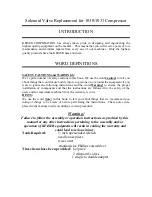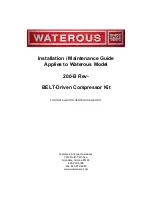
4. ASSEMBLY
4.1.
Remove compressor from packaging and inspect for any shortages or damage. If anything is found to be missing or damaged contact
your Sealey stockist.
4.2.
Save the packing material for future transportation of the compressor. We recommend that you store the packing in a safe location, at
least for the period of the guarantee. Then, if necessary, it will be easier to send the compressor to the service centre.
4.3.
Confirm that the mains voltage corresponds with the voltage shown on the compressor data plate.
4.4.
Position the compressor on a flat surface or with a maximum
permissible inclination of 10
0
. Site in a well ventilated place, protected
against atmospheric pollution and not in a place subject to explosion hazard. If the surface is inclined and smooth, check if the
compressor moves while in operation. If the surface is inclined make sure it cannot fall, securing it in a suitable way.
4.5.
To ensure good ventilation and efficient cooling, the compressor’s belt guard must be at least 100cm from any wall (fig.2).
Compressors fitted on the tank, with fixed feet, should not be rigidly secured to the ground. In this case, we advise you to fit 4
anti-vibration supports. Fit the 4 anti-vibration supports, raise the compressor using a suitable pallet truck or fork lift and push the
supports onto the base of each foot (fig.3).
4.6.
Take care to transport the compressor correctly,
DO NOT
overturn it or lift it with hooks or ropes.
4.7.
Remove the plastic transit plug from the oil filler hole (fig.4A) and replace it with the filler/breather plug as shown in fig.4B. It is a
push fit, ensure that it is pushed fully home.
4.8.
Before using the compressor, check the oil level by observing the sight glass as shown in fig.5. If the oil is not up to the max mark
it should be topped up with synthetic oil suitable for temperatures ranging from -5°C to 45°C (viscosity 5W50). We
DO NOT
recommend
using mineral oil in these compressors.
DO NOT
overfill.
NOTE:
To gain access to the pump and motor you must remove the 4 bolts from the top lid of the sound proof casing. For
some servicing such as draining oil, you must also remove the rear panel by removing the 4 bolts.
5. OPERATION
WARNING!
Ensure that you have read, understood and apply Section 1 safety instructions.
IMPORTANT!
The use of extension leads to connect this compressor to the mains supply is not recommended as the resulting voltage
drop reduces motor, and therefore pump performance and could cause damage to your compressor.
NOTE:
Take care when selecting tools for use with the compressor. Air tool manufacturers normally express the volume of air required
to operate a tool in cubic feet per minute (cfm). This refers to free air delivered by the compressor (‘air out’) which varies according
to the pressure setting.
DO NOT
confuse this with the compressor displacement which is the air taken in by the compressor (‘air in’).
‘Air out’ is always less than ‘air in’ due to losses within the compressor.
5.1.
STARTING THE COMPRESSOR
5.1.1.
To turn the compressor on, plug mains lead into mains supply,
press the “ON” button on the front panel See fig.6.
5.1.2.
When starting the compressor for the first time, leave it running with no air tools connected to the air outlet. Make sure that
pressure in the tank rises and that the compressor stops automatically when the maximum pressure value allowed (written on the
plate and shown on the gauge in fig.6) is achieved. The compressor will now operate automatically. The pressure switch stops the motor
when the maximum tank pressure is reached and restarts it when the pressure falls below the minimum threshold - approx. 2bar (29psi)
less than the maximum pressure.
5.1.3.
Stop the compressor by pressing the “OFF/RESET” button in fig.6. The compressed air inside the compressor head will flow out, making
fig.2
fig.4
Oil Drain
fig.5
SAC2203BLN.V2 Issue 2 (H, 3, F) 09/07/18
Original Language Version
© Jack Sealey Limited
fig.3























